- July 22, 2023
- admin
- (0)
- Bunnies For Sale
Rabbits are susceptible to a range of diseases that affects rabbits. By getting all information about these diseases and proper care can improve the chances of health and longevity.
Common conditions of pet rabbits can encompass a variety of diseases that affect rabbits. Maintaining a proactive approach to your rabbit’s health and seeking proper veterinary care can mitigate parasite risks and provide your furry companion with a happy and healthy life. Always use reliable and credible sources when gathering information about your pet’s health to ensure their well-being.
Additionally, it’s essential to maintain good hygiene practices and take precautions to prevent zoonotic transmission to humans and other pets. By staying informed and proactive, rabbit owners can provide their beloved pets with the best possible care and enjoy many happy and healthy years together.
Common Diseases That Affect Rabbits And Their Symptoms
Rabbits are susceptible to a range of diseases, and one prevalent condition is gastrointestinal stasis. Being vigilant about these common diseases and seeking prompt veterinary care can significantly improve the chances of a rabbit’s health and longevity. In this post we will explain all the common diseases that affect rabbits and their symptoms.
1. Respiratory Tract Infections And Pneumonia
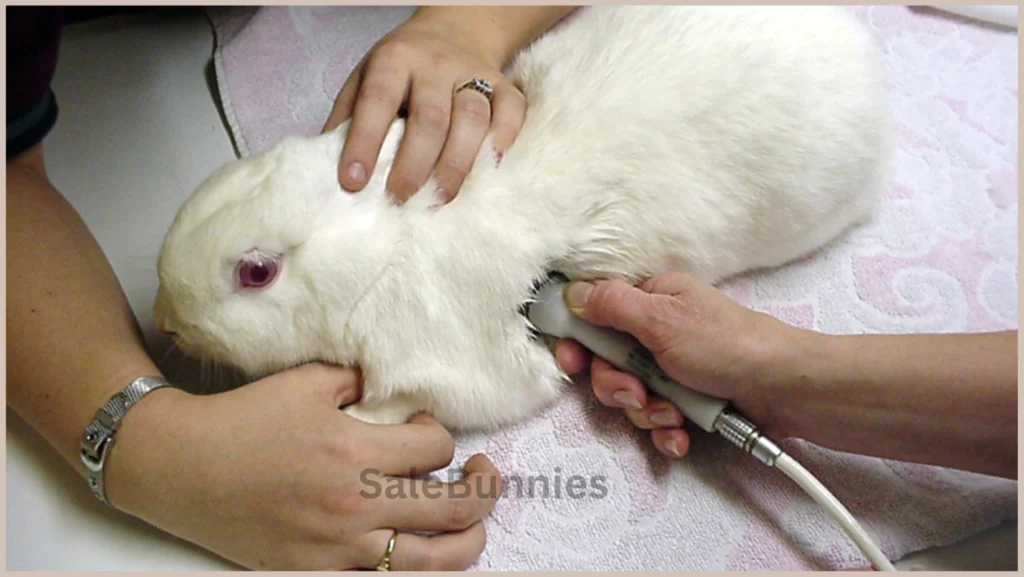
Respiratory tract infections, commonly known as “snuffles.” Bacteria are frequently responsible for snuffles, a common upper respiratory tract infection in rabbits, with Pasteurella multocida being a typical problem.
Symptoms
Clinical manifestations typically involve the eyes (characterized by mucus or pus-like discharge, redness, and squinting) and the nose and sinuses (resulting in sneezing, mucus, or pus-like discharge).
Commonly, the nose and eyes are also affected, which causes the rabbit to rub, creating crusty and matted fur on the inside of the front paws. It is essential to note that Pasteurella multocida can also infect other areas of the rabbit’s body.
Pneumonia Infection
This includes pneumonia caused by a bacterial infection in the lungs, ear infections that may cause a head tilt, the development of abscesses (visible as lumps on the body). Even though it’s rare, a condition called an infection of the blood can result in rapid death.
2. Uterine Cancer
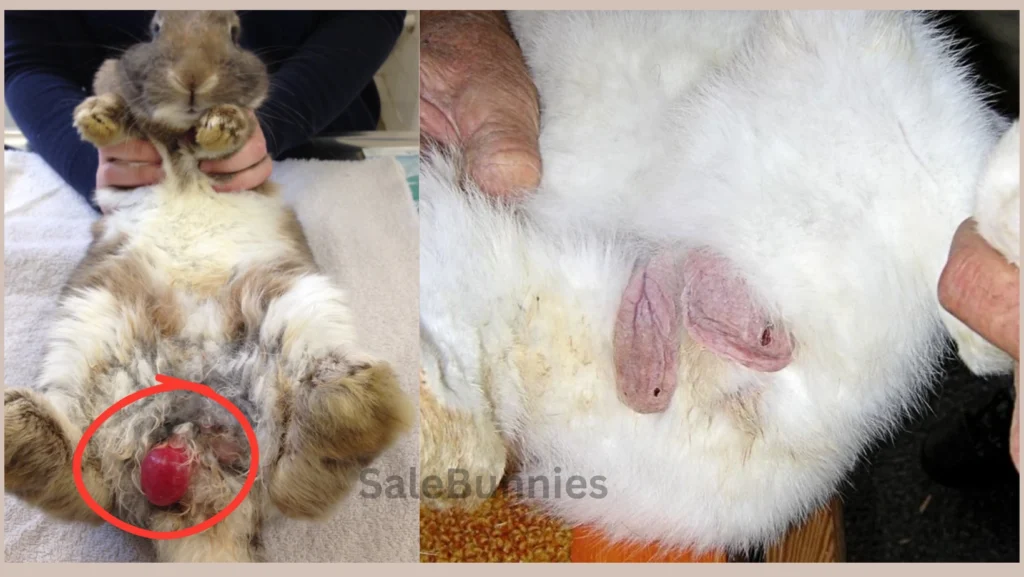
Spaying female rabbits at a young age, typically 5-6 months, is crucial to ensure their long-term health and well-being. Spaying involves the surgical removal of the uterus, which eliminates the risk of developing uterine infections and significantly reduces the chances of uterine adenocarcinoma, a dangerous form of uterine cancer.
Uterine adenocarcinoma is a malignant tumor that arises in the glands of the uterus. Unspayed female rabbits are at high risk of developing this cancer, which can lead to serious health complications if left untreated.
Uterine adenocarcinoma, a common type of cancer in unspayed female rabbits, affects over 70% after three years of age.
Symptoms
One of the common symptoms of uterine adenocarcinoma is bloody urine, which should raise concerns and prompt a visit to the veterinarian for further evaluation.
Diagnosing Uterine Cancer in Rabbits
Veterinarians can suspect uterine cancer in an unspayed female rabbit by physical examination and palpating the abdomen for an enlarged uterus. Additionally, X-rays can be used to visualize an enlarged uterus.
However, a definitive diagnosis usually requires exploratory surgery to remove the uterus, allowing the veterinarian to examine the tissue and confirm the presence of cancer.
Prevention and Treatment of Uterine Cancer
Early spaying is the most effective way to prevent uterine adenocarcinoma in female rabbits. By removing the uterus before the rabbit reaches sexual maturity, the risk of developing this type of cancer is virtually eliminated.
If uterine cancer is detected, timely surgical removal of the affected uterus offers a high chance of successful treatment.
3. Pododermatitis

Pododermatitis, commonly known as “sore hocks,” is a prevalent and distressing condition that affects rabbits, especially those kept in wire-bottomed cages. As these gentle creatures spend much time resting on their hocks, the constant friction against the harsh wire surface gradually removes the protective fur layer on the sole and the hock itself.
Symptoms
The skin on the rabbit’s feet becomes inflamed and red, ulcerated, and extremely painful for the rabbit, making it difficult for them to move comfortably.
Prevention and Treatment
Responsible rabbit owners must prioritize their pets’ living conditions to ensure their furry companions’ well-being and prevent pododermatitis development. The most effective preventive measure is removing rabbits entirely from wire-bottomed cages and providing them with spacious, smooth enclosures.
Rabbits can rest on a less abrasive surface by choosing appropriate materials, such as wood or Plexiglas, for a section of the cage floor, significantly reducing the pressure on their delicate feet and hocks.
Regular Inspections
In addition to addressing the housing conditions, it is crucial to implement regular hygiene practices and proper grooming to minimize the risk of pododermatitis. Moreover, regular inspections of the rabbits’ feet are essential to identify any early signs of pododermatitis and seek prompt veterinary attention.
Veterinary Consultation
If pododermatitis does occur, immediate action is required to alleviate the rabbit’s pain and discomfort. Veterinary consultation is vital to assess the severity of the condition and provide appropriate treatment, which may include topical medications, antibiotics to prevent infections, and pain management.
Regular exercise
Furthermore, ensuring rabbits have ample space to move around and engage in natural behaviors is essential for their overall well-being. Regular exercise and mental stimulation contribute to their happiness and prevent issues related to prolonged inactivity, such as obesity and muscle weakness.
As responsible caretakers, you must empathize with your animal companions and take every possible measure to keep them healthy and content. By prioritizing appropriate housing, regular grooming, and proactive veterinary care, you can safeguard rabbits from the agony of pododermatitis and provide them with the safe and nurturing environment they deserve.
4. Internal and External Parasites
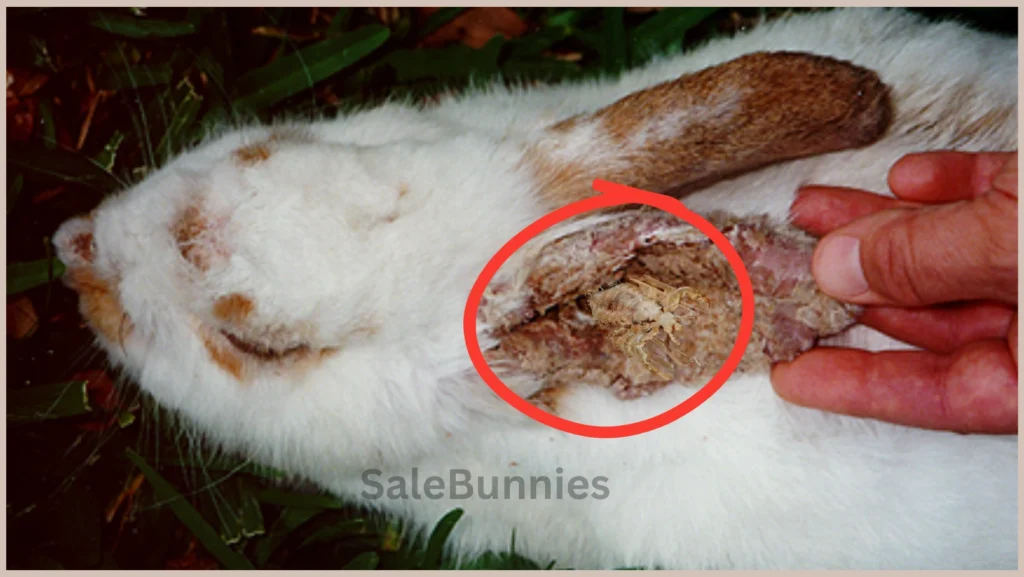
Rabbits can suffer from various internal and external parasites, which can cause multiple symptoms and health issues. Some common parasites affecting rabbits include fleas, mites, ticks, worms (such as pinworms and tapeworms), and coccidia (a protozoan parasite). Here are the symptoms and treatment options for rabbits suffering from these parasites:
Symptoms of Internal Parasites
1. Diarrhea or soft
2. Weight loss
3. Lethargy or weakness
4. Reduced appetite or anorexia
5. Pot-bellied appearance in severe infestations
6. Anemia (pale gums and mucous membranes)
7. Visible worms in feces (e.g., pinworms or tapeworm segments)
Symptoms of External Parasites
1. Itching and scratching
2. Hair loss or thinning fur
3. Red or irritated skin
4. Presence of tiny insects (fleas, mites, or ticks) on the rabbit’s coat
Treatment of Parasites
- If you suspect your rabbit has parasites, it’s essential to take them to a veterinarian experienced in rabbit care. They will perform a thorough examination and might request fecal samples to diagnose internal parasites accurately.
- Depending on the specific parasite infestation, the vet will prescribe appropriate medications, such as anti-parasitic drugs or antibiotics, to treat secondary infections caused by parasites.
- For external parasites like fleas, mites, or ticks, the vet may recommend topical treatments or spot-on products specifically designed for rabbits.
- Cleaning and disinfecting the rabbit’s living area is crucial to prevent reinfestation of parasites.
- Supportive care, such as ensuring the rabbit stays well-hydrated and receives proper nutrition, can aid in its recovery.
5. Tooth or Jaw Trauma

Rabbits possess continuously growing teeth, and their daily chewing habits, such as gnawing on wooden blocks, branches, and toys, help to naturally wear down. Their teeth at a rate matching their growth.
However, certain factors like tooth or jaw trauma and diseases can disrupt the natural growth pattern of their teeth, leading to misalignment of the upper and lower jaws and causing the teeth to overgrow, preventing proper wear during chewing. This can affect their molars and incisors (the prominent teeth at the front of their mouth).
Symptoms
Tooth congestion or malocclusion can cause pain, vomiting, and other oral health problems.
Treatment
Maintaining a diet of high-fiber food, mainly hay, aids in keeping their teeth at a healthy and functional length.
6. Overgrown Teeth
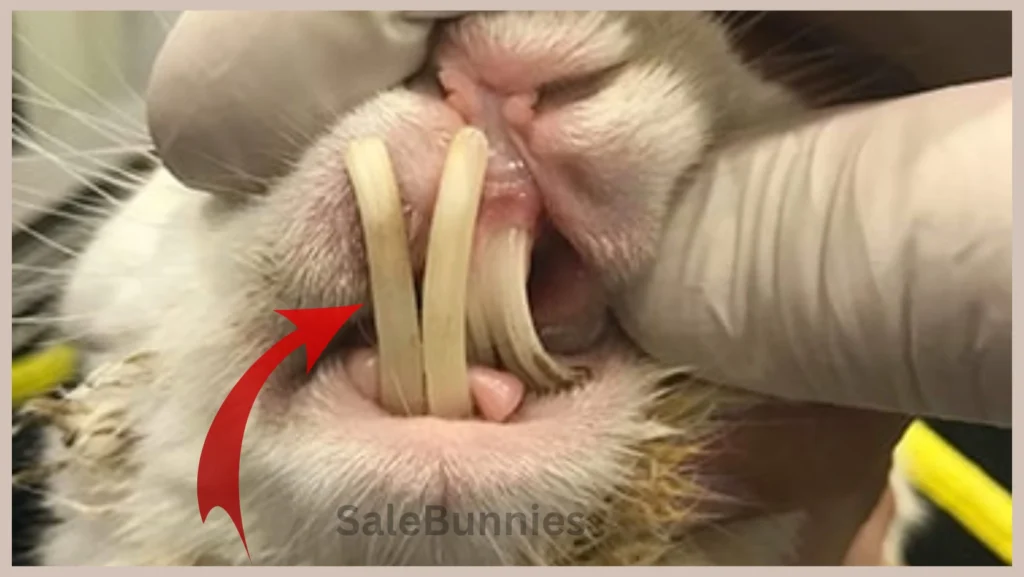
Detecting issues with the incisors can be done simply by lifting the rabbit’s lips and inspecting its mouth. However, assessing the molars, located further back in the mouth, requires the expertise of a veterinarian experienced in dealing with rabbits. Recognizing signs of dental issues in rabbits is essential.
Symptoms
The symptoms of overgrowth are stop eating, exhibit teeth grinding due to pain, drool excessively, drop food from their mouths, and experience weight loss.
7. GI Stasis
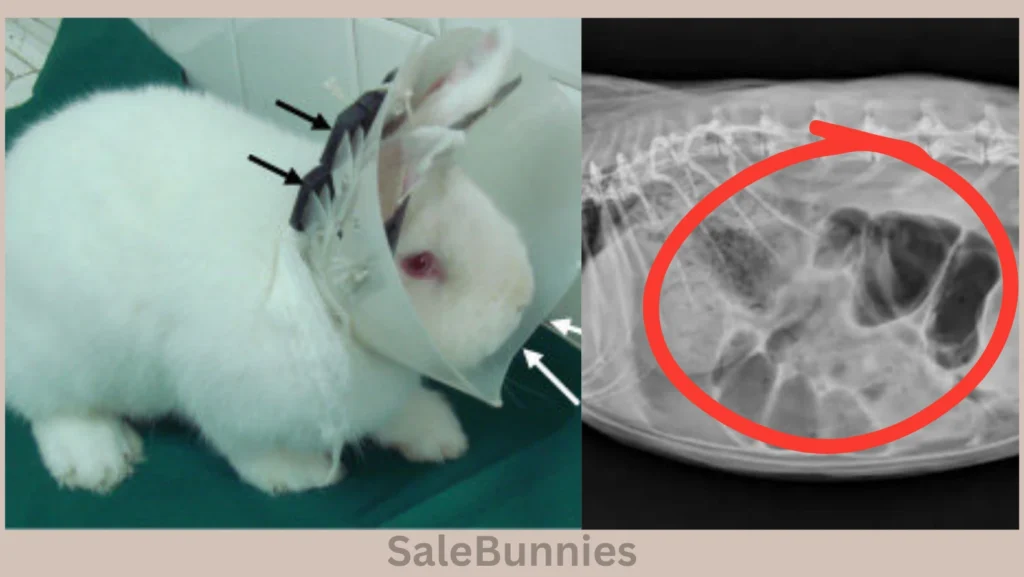
When a rabbit ceases to eat, regardless of the cause (dental disease, stress, or respiratory tract infection), it can disrupt the average balance of bacteria in its gastrointestinal (GI) tract. This imbalance may lead to the overgrowth of harmful bacteria that produce gas and toxins.
They further suppress the rabbit’s appetite and worsen the condition, possibly even leading to death if left untreated. This condition, known as GI stasis, is prevalent in rabbits, but early diagnosis by a veterinarian can lead to successful treatment.
Treatment
- Administering fluids (subcutaneously or intravenously).
- Syringe feeding.
- Using GI motility-enhancing drugs to aid recovery.
FAQs
How can I prevent rabbit diseases?
To prevent rabbit diseases, ensure your rabbit has a clean and spacious living environment, a balanced diet, regular veterinary check-ups, and limited contact with other potentially infected animals.
What should I do if I notice any of these symptoms in my rabbit?
If you observe any concerning symptoms in your rabbit, it’s crucial to seek veterinary attention immediately. Early diagnosis and treatment can significantly improve the chances of recovery.
Are there any zoonotic risks associated with rabbit diseases?
Some rabbit diseases, like Pasteurellosis and Ringworm, can be transmitted to humans. Take precautions, such as frequent handwashing and wearing gloves when handling sick rabbits. Consult a healthcare professional if you develop symptoms after contact with a sick rabbit.
Final Verdict
Rabbit owners must be aware of common diseases that affect rabbits and their associated symptoms to ensure the well-being of their furry companions. Rabbit Hemorrhagic Disease, Pasteurellosis, E. cuniculi infection, Myxomatosis, and Coccidiosis are some other prevalent diseases that affect rabbits.
Recognizing the symptoms early on and seeking prompt veterinary attention is vital for successful treatment and recovery. Regular veterinary check-ups, a clean living environment, balanced nutrition, and appropriate vaccinations can significantly reduce the risk of these


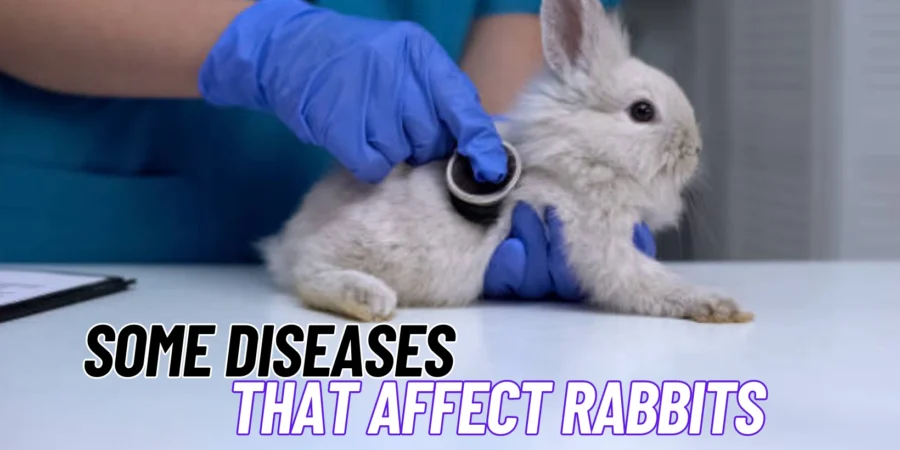
Leave a Reply